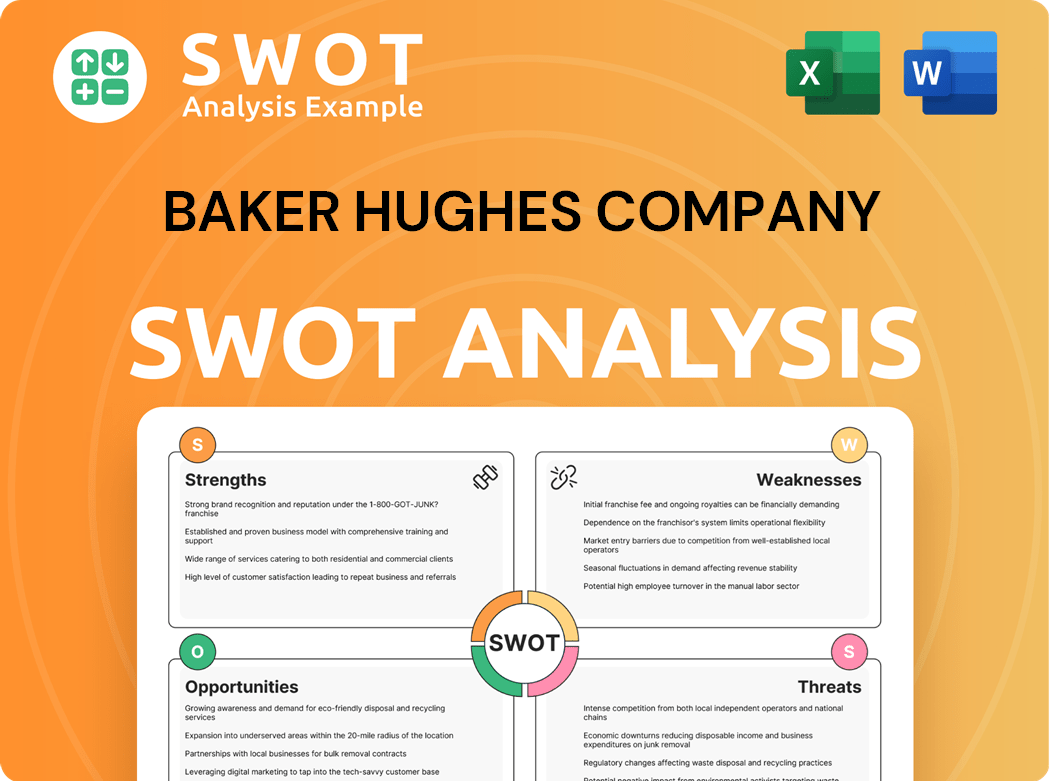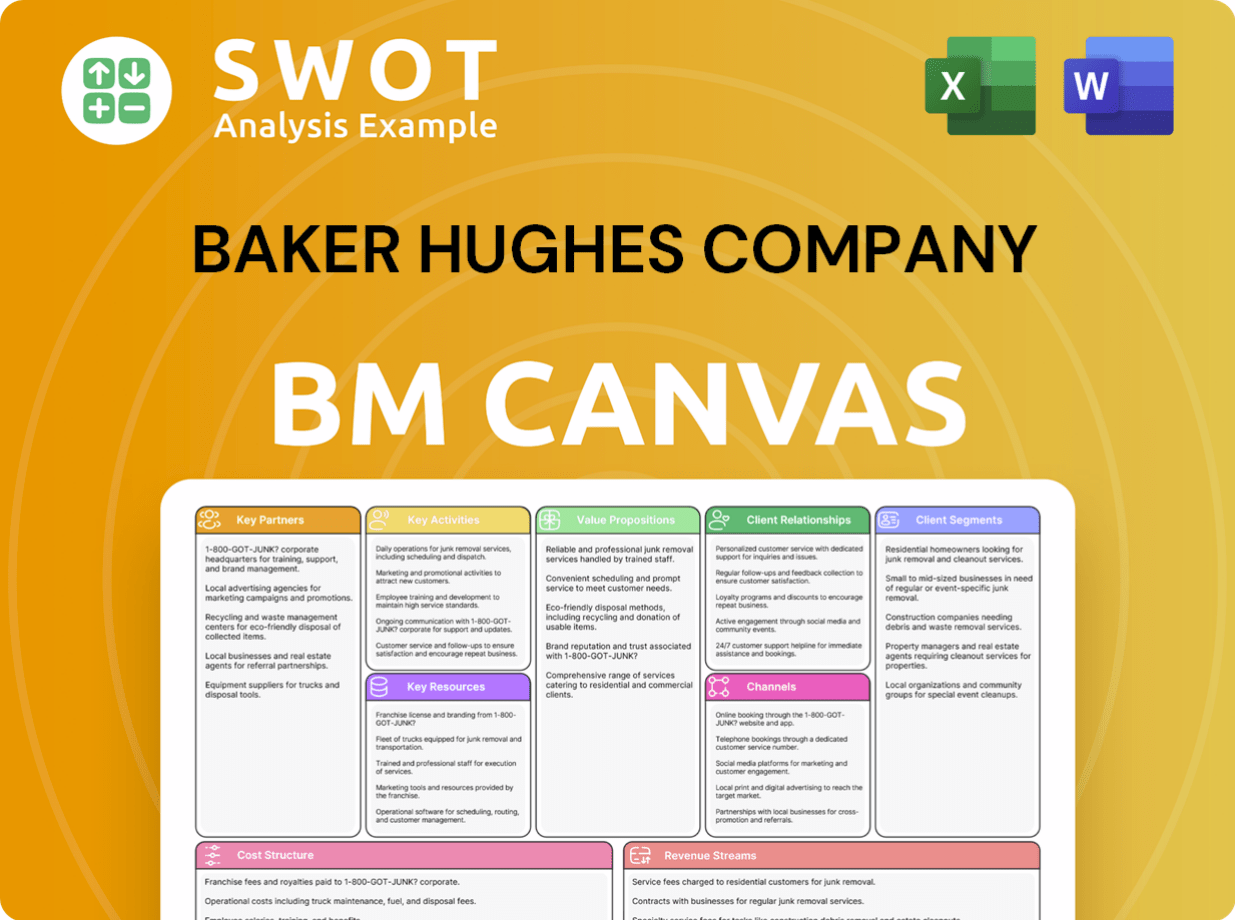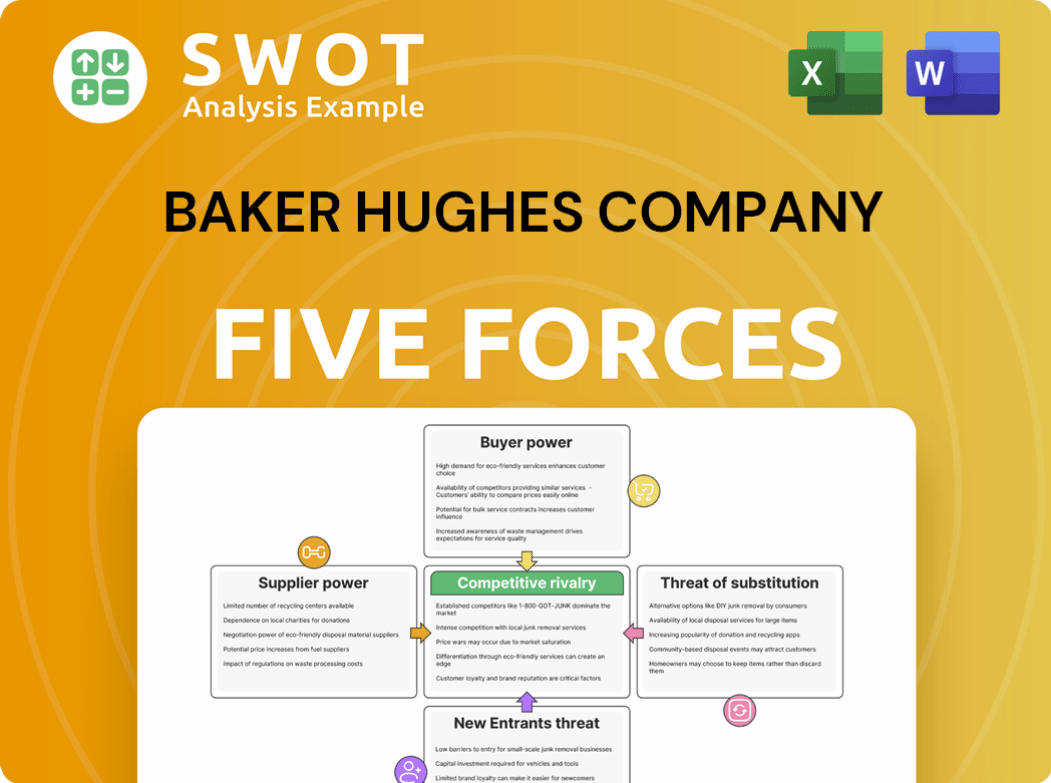Baker Hughes Company Bundle
How Does Baker Hughes Company Thrive in the Energy Transition?
Baker Hughes Company, a leading energy technology provider, is at the forefront of the evolving energy landscape, offering vital solutions across the oil and gas sector and beyond. As the world shifts towards a more sustainable energy future, understanding Baker Hughes operations is key to navigating the complexities of the energy market. This exploration delves into how Baker Hughes enables its customers to optimize their operations, reduce environmental impact, and drive productivity.

From advanced Baker Hughes Company SWOT Analysis to sophisticated digital platforms, Baker Hughes is an indispensable partner in the energy industry. This analysis will dissect the core mechanisms driving Baker Hughes, examining its revenue streams, strategic initiatives, and competitive positioning within the dynamic energy industry. Whether you're interested in oil and gas services, Baker Hughes operations, or the broader energy technology landscape, this comprehensive overview provides valuable insights.
What Are the Key Operations Driving Baker Hughes Company’s Success?
The core of Baker Hughes Company's (BHGE) operations centers around providing a wide array of products, services, and digital solutions. These offerings are specifically designed for the energy and industrial sectors. The company’s focus includes equipment and systems for the exploration, production, and processing of oil and gas, alongside advanced digital solutions for industrial applications.
Baker Hughes serves key customer segments such as national and international oil companies, independent oil and gas producers, and various industrial enterprises. Its operational processes are multifaceted, encompassing the design, manufacturing, and servicing of highly engineered equipment, as well as extensive research and development efforts to create new technologies. The company's approach is unique due to its integration of deep domain expertise in oil and gas with cutting-edge digital capabilities.
A crucial element of Baker Hughes operations involves its global supply chain, which ensures the timely delivery of complex machinery and components. It utilizes strategic partnerships and an expansive distribution network to reach customers worldwide. This enables the deployment and maintenance of its solutions across diverse geographical regions. For instance, the i-DOSE automated drilling solution is designed to enhance drilling efficiency and reduce operational costs. This integration translates into significant customer benefits, such as improved operational efficiency, reduced downtime, enhanced safety, and lower carbon emissions, ultimately differentiating Baker Hughes in a competitive market.
Baker Hughes offers a wide range of equipment and systems. These include products for oil and gas exploration, production, and processing. They also provide solutions for the industrial sector, covering various needs from upstream to downstream operations.
The company provides advanced digital solutions. These solutions focus on enhancing operational efficiency and asset performance. They utilize technologies like AI and digital twins for predictive maintenance and optimization.
Baker Hughes operates a global supply chain. This ensures the timely delivery of complex machinery and components. The company leverages partnerships and distribution networks to reach customers worldwide.
Baker Hughes focuses on serving key customer segments. These include national and international oil companies, independent producers, and industrial enterprises. The company aims to meet the specific needs of each segment.
Baker Hughes's integrated approach combines deep domain expertise with cutting-edge digital capabilities. This integration allows for optimized drilling, production, and processing, as well as predictive maintenance through digital twins and AI-powered analytics. The company's focus on innovation and digital transformation is evident in its strategic initiatives. For example, in 2024, Baker Hughes announced new partnerships to advance its digital solutions for energy and industrial applications.
- Digital Transformation: Investing in digital solutions for improved efficiency and performance.
- Sustainability: Initiatives aimed at reducing carbon emissions and supporting the energy transition.
- Global Presence: Operating in numerous countries to serve a diverse customer base.
- Innovation: Continuous research and development to create new technologies and solutions.
Baker Hughes Company SWOT Analysis
- Complete SWOT Breakdown
- Fully Customizable
- Editable in Excel & Word
- Professional Formatting
- Investor-Ready Format

How Does Baker Hughes Company Make Money?
The Baker Hughes Company generates revenue through a diverse range of products, services, and digital solutions. These offerings are primarily categorized into segments like Oilfield Services and Equipment (OFSE), Industrial & Energy Technology (IET), and Digital Solutions. The company's financial performance is closely tied to the energy industry's cyclical nature, but it is actively diversifying to mitigate risks and capitalize on emerging opportunities.
Revenue streams encompass direct sales of equipment, long-term service agreements, and subscription-based models for digital platforms. This multifaceted approach allows Baker Hughes to maintain a consistent revenue flow. The company's strategic focus on new energy technologies, such as carbon capture and hydrogen solutions, is expected to contribute significantly to future revenue growth.
In Q1 2024, Baker Hughes reported total revenues of $6.4 billion, reflecting a 6% sequential increase. Oilfield Services & Equipment (OFSE) revenue was $4.0 billion, a 5% sequential increase, while Industrial & Energy Technology (IET) revenue was $2.4 billion, a 7% sequential increase. These figures highlight the company's robust performance across its key segments.
The monetization strategies of Baker Hughes involve a blend of product sales, service contracts, and digital solutions. The company's approach includes tiered pricing for digital offerings and cross-selling opportunities to enhance customer value. Furthermore, the company's focus on new energy technologies is a strategic move to tap into the growing demand for sustainable energy solutions. For a broader view of the competitive environment, consider exploring the Competitors Landscape of Baker Hughes Company.
- Direct Sales: Revenue from the sale of oilfield equipment, industrial machinery, and related products.
- Service Agreements: Long-term contracts for equipment maintenance, repair, and optimization services.
- Digital Solutions: Subscription-based revenue from software platforms for data analytics, production optimization, and asset management.
- New Energy Technologies: Revenue from offerings related to carbon capture, hydrogen, and geothermal solutions.
Baker Hughes Company PESTLE Analysis
- Covers All 6 PESTLE Categories
- No Research Needed – Save Hours of Work
- Built by Experts, Trusted by Consultants
- Instant Download, Ready to Use
- 100% Editable, Fully Customizable

Which Strategic Decisions Have Shaped Baker Hughes Company’s Business Model?
Baker Hughes Company has undergone significant transformations, with key milestones and strategic shifts shaping its trajectory. A major turning point was the merger with GE Oil & Gas in 2017, which boosted its technological capabilities and global reach. This move, although followed by GE's divestiture, set the stage for its evolution into an energy technology company.
The company is actively transitioning beyond traditional oil and gas services, venturing into new energy frontiers. This involves strategic investments and partnerships in areas like carbon capture, utilization, and storage (CCUS), hydrogen, and geothermal energy. This proactive approach reflects its commitment to the global energy transition and positions it for future growth.
Operational challenges have included the cyclical nature of the oil and gas market, supply chain disruptions, and the increasing pressure for decarbonization. Baker Hughes has responded by streamlining operations, investing in digital transformation to enhance efficiency, and diversifying its portfolio. Its competitive advantages stem from its extensive technological leadership, particularly in advanced drilling, production, and digital solutions.
The merger with GE Oil & Gas in 2017 expanded technological capabilities and global footprint. Divestiture of GE's stake marked a shift in ownership. Focus on energy technology, including CCUS, hydrogen, and geothermal, highlights strategic adaptation.
Transitioning to an energy technology company is a core strategy. Investments and partnerships in sustainable energy solutions, such as hydrogen and CO2 compression technologies, are key. Streamlining operations and digital transformation enhance efficiency and diversification.
Technological leadership in drilling, production, and digital solutions provides an advantage. Strong brand recognition, global presence, and economies of scale bolster market position. Extensive intellectual property portfolio enables proprietary solutions and superior performance.
Announced collaborations in 2024 to advance hydrogen production and CO2 compression technologies. Prioritizing R&D in AI, machine learning, and automation to stay at the forefront. Adapting to evolving industry demands and competitive threats.
Baker Hughes benefits from its extensive technological leadership in oil and gas services, including advanced drilling and production optimization. The company's strong brand recognition and global presence further solidify its market position in the energy industry. Economies of scale and an extensive intellectual property portfolio contribute to its competitive edge, allowing it to offer proprietary solutions.
- Technological leadership in advanced drilling and production.
- Strong brand recognition and global presence.
- Extensive intellectual property portfolio.
- Focus on digital solutions and production optimization.
The company's history, as detailed in the Brief History of Baker Hughes Company, shows a consistent evolution. In 2024, the company continues to adapt, with a focus on digital solutions and production optimization. Its commitment to innovation, particularly in areas like artificial intelligence and machine learning, ensures its offerings remain at the forefront of energy technology. This proactive approach addresses evolving industry demands and competitive threats.
Baker Hughes Company Business Model Canvas
- Complete 9-Block Business Model Canvas
- Effortlessly Communicate Your Business Strategy
- Investor-Ready BMC Format
- 100% Editable and Customizable
- Clear and Structured Layout

How Is Baker Hughes Company Positioning Itself for Continued Success?
The Baker Hughes Company (BHGE) holds a significant position within the global energy technology and services sector. It competes with major players like Schlumberger and Halliburton, maintaining a substantial market share across its various segments. Its extensive portfolio of advanced technologies and integrated solutions contributes to customer loyalty, as clients often depend on Baker Hughes operations for comprehensive support throughout their energy projects.
However, the company faces several key risks. These include the inherent volatility of crude oil and natural gas prices, which can directly impact exploration and production spending by its customers. Regulatory changes related to environmental protection and climate change, particularly those promoting decarbonization, could also influence demand for traditional oil and gas services. The emergence of new competitors, especially in the rapidly evolving new energy sector, and the risk of technological disruption from innovative startups or rival firms, also pose challenges.
Baker Hughes operates in over 120 countries, providing oil and gas services and energy technology. The company's diverse portfolio includes oilfield equipment, drilling services, and subsea systems. A strong global presence and established customer relationships support its market position.
Key risks include fluctuating oil and gas prices, which impact exploration and production spending. Regulatory changes and the shift towards decarbonization also present challenges. Competition from new energy sector players and technological disruptions pose further threats.
Baker Hughes is strategically positioned to benefit from both traditional energy demand and the energy transition. The company is investing in digital solutions and expanding its New Energy portfolio. Leadership is focused on balancing hydrocarbon production with cleaner energy solutions.
The company aims to leverage its technological expertise to address global energy challenges. This includes growth opportunities in hydrogen, carbon capture, and geothermal energy. Continuous optimization of core oil and gas operations is also a priority.
In recent years, Baker Hughes Company has focused on streamlining its operations and expanding its presence in the New Energy sector. The company is actively involved in projects related to carbon capture, hydrogen, and geothermal energy. The company's strategic moves are detailed in Growth Strategy of Baker Hughes Company.
- Digital Solutions: Investment in digital technologies to enhance operational efficiency and reduce emissions.
- New Energy Portfolio: Expansion into areas like hydrogen, CCUS (Carbon Capture, Utilization, and Storage), and geothermal.
- Sustainable Industrial Solutions: Focus on optimizing core oil and gas operations for efficiency and sustainability.
- Financial Data: In 2024, the company's revenue was approximately $25 billion, reflecting its strong market position and strategic initiatives.
Baker Hughes Company Porter's Five Forces Analysis
- Covers All 5 Competitive Forces in Detail
- Structured for Consultants, Students, and Founders
- 100% Editable in Microsoft Word & Excel
- Instant Digital Download – Use Immediately
- Compatible with Mac & PC – Fully Unlocked

Related Blogs
- What are Mission Vision & Core Values of Baker Hughes Company Company?
- What is Competitive Landscape of Baker Hughes Company Company?
- What is Growth Strategy and Future Prospects of Baker Hughes Company Company?
- What is Sales and Marketing Strategy of Baker Hughes Company Company?
- What is Brief History of Baker Hughes Company Company?
- Who Owns Baker Hughes Company Company?
- What is Customer Demographics and Target Market of Baker Hughes Company Company?
Disclaimer
All information, articles, and product details provided on this website are for general informational and educational purposes only. We do not claim any ownership over, nor do we intend to infringe upon, any trademarks, copyrights, logos, brand names, or other intellectual property mentioned or depicted on this site. Such intellectual property remains the property of its respective owners, and any references here are made solely for identification or informational purposes, without implying any affiliation, endorsement, or partnership.
We make no representations or warranties, express or implied, regarding the accuracy, completeness, or suitability of any content or products presented. Nothing on this website should be construed as legal, tax, investment, financial, medical, or other professional advice. In addition, no part of this site—including articles or product references—constitutes a solicitation, recommendation, endorsement, advertisement, or offer to buy or sell any securities, franchises, or other financial instruments, particularly in jurisdictions where such activity would be unlawful.
All content is of a general nature and may not address the specific circumstances of any individual or entity. It is not a substitute for professional advice or services. Any actions you take based on the information provided here are strictly at your own risk. You accept full responsibility for any decisions or outcomes arising from your use of this website and agree to release us from any liability in connection with your use of, or reliance upon, the content or products found herein.